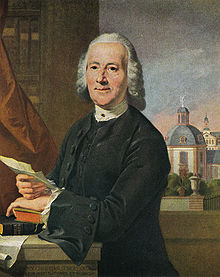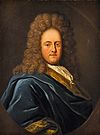Johann Christian Senckenberg
Johann Christian Senckenberg (born February 28, 1707 in Frankfurt am Main ; † November 15, 1772 ibid) was a German doctor , founder , natural scientist and botanist . After completing his studies, he worked as a doctor in Frankfurt. After marrying three times and all of his wives and children died, he dedicated himself to his foundation. As the founder of Dr. Senckenberg Foundation in 1763 he laid the foundation stone for the Bürgerhospital Frankfurt . He could no longer see the opening of the hospital. He died in 1772 while inspecting the building site. Senckenberg is today, among other things, namesake of the Senckenberg Society for Nature Research and its institutes and museums as well as the Johann Christian Senckenberg University Library .
Life
Johann Christian Senckenberg was born on February 28, 1707 in the Frankfurt Hasengasse in the house "To the Three Little Bunnies". He was the second eldest son of the Frankfurt city physician (Physikus primarius) Johann Hartmann Senckenberg (1655-1730) and his second wife Anna Margaretha née Raumburger (1682-1740). He attended the municipal high school in the former barefoot monastery, in 1719, when Senckenberg was twelve years old , Senckenberg's house burned down in the Great Christian Fire , the worst fire disaster in Frankfurt up to the Second World War. Rebuilding the house created financial difficulties for the family. Although Senckenberg received a grant of 100 guilders from the city four years later , his start to studies was delayed due to the financial situation.
In the meantime, Senckenberg sat in on the senior physician of the noble family Solms and the Frankfurt doctors Büttner and Grambs. His father taught him practical medicine. In 1730 he was able to start studying medicine at the University of Halle . His teachers in Halle included Friedrich Hoffmann and Georg Ernst Stahl . In July 1731 he had to break off his studies in Halle. The deeply religious Senckenberg was impressed by the theologian Johann Konrad Dippel and got involved in theological arguments and refused the Eucharist and the cloister . But he had turned away from the state church early on and was in contact with Pietists , inspirational communities and Herrnhutern . In Halle he got to know August Hermann Francke's charitable institutions , including an orphanage and a hospital.
Senckenberg therefore returned to Frankfurt in the spring of 1732 and practiced as a doctor there without a license to practice medicine . After suffering from psychological problems, his older brother Heinrich Christian Senckenberg helped him to get his doctorate at the Georg-August-Universität Göttingen in 1737 . Under the chairmanship of Albrecht von Haller , he dealt in his dissertation with the healing power of the lily of the valley ( De Lilii convallium eiusque inprimis baccae viribus .: “About the healing power of the lily of the valley berries”). In the following years Senckenberg was involved as "Physicus extraordinarius", from 1755 as "Physicus Ordinarius" for the health system in Frankfurt.
After the death of his mother in 1740, Senckenberg married the jeweler daughter (Joh-) Anna Rebecca Riese in 1742. In the same year he took the citizenship oath . The two had been neighbors as children and have known each other ever since. On October 26, 1743, Riese died of puerperal fever after the birth of their daughter . The daughter Anna Margarethe Senckenberg died in 1745 of meningitis . Senckenberg married again as early as 1744. His second wife, Katharina Rebecca von Mettingh, was a friend of Senckenberg's first wife. She died of tuberculosis in 1747, as did her son, who was born in June 1747 . In 1754 Senckenberg married a third time. The marriage with Antonetta Elisabetha Ruprecht did not go well, however, and from 1756 they lived separately. Ruprecht suffered from cancer . Senckenberg also treated her after the separation, but she died at the end of 1756.
After the death of his three wives and children, he decided to donate all of his fortune to the public pro bono publico patriae . Senckenberg named the “lack of marital heirs” and “love for my fatherland” as the reason for the foundation. The purpose of the foundation should be "better health care for local residents and care for the poor sick". The foundation's assets of 95,000 guilders came partly from the legacy of Anna Rebecca Riese, but he had also made a fortune as a doctor.
Senckenberg stipulated that a “Collegium medicum” made up of Frankfurt Protestant doctors were the heirs to the foundation's assets, and four city doctors were executors of wills. Two thirds of the interest on the foundation capital was to be used to promote medicine, but initially it was used to maintain the Senckenberg residential building, which was equipped with the library and collection of the monastery building. The third third should be used to care for doctors and sick people in need. In 1765 Senckenberg rounded up the foundation's assets to 100,000 guilders. He severely restricted the board of trustees and gave his older brother and his descendants a say in the administration of the foundation. The foundation became Dr. Senckenberg Foundation and took the coat of arms of the Senckenberg family, a burning bush, with the inscription Fundatio Senckenbergiana amore Patriae : Senckenberg Foundation out of love for the hometown.

Senckenberg already had plans to build a building on the outskirts with a garden, laboratory, botanical garden and greenhouse. In 1766, Senckenberg acquired a three-hectare property at Eschenheimer Tor for 23,000 guilders . From 1767 the building became Senckenberg's seat and residence. On July 9, 1771, Senckenberg laid the foundation stone for the Frankfurt Bürgerhospital . During an inspection of the building, Senckenberg fell from the scaffolding of the hospital dome on November 15, 1772 and died. On November 17th, he was publicly dissected in the "Theatrum anatomicum" he had donated, although he had refused a dissection in his will. A cervical spine fracture with ascending bleeding in the spinal canal was given as the cause of death. Senckenberg's nephew Renatus Karl von Senckenberg noted in a report on Senckenberg " All of Frankfurt regretted its loss ". On November 18, 1772, Frankfurt surgeons, accompanied by Renatus von Senckenberg, as well as the foundation administration and other mourners, carried Senckenberg's coffin to the crypt on the monastery building.
Senckenberg wrote diaries during his studies. A total of 53 diary volumes and 600 folders with further records are now in the Johann Christian Senckenberg University Library . There are a total of 40,000 pages. Due to his handwriting, which is difficult to read, a mixture of German, Frankfurterisch, Latin, Greek, French and English as well as numerous abbreviations of his own, reading and transcribing the diaries is very difficult. Since 2011, a project at the Frankfurt University Library has been working on initially bringing around 13,000 diary pages from the years 1730 to 1742 into a form that is readable today and making them available online as digital copies.
Senckenberg as namesake

- Dr. Senckenberg Foundation . Senckenbergs Foundation
- Senckenberg Society for Nature Research . A company independent of the Foundation, established in 1817. The company established:
- (207687) Senckenberg , an asteroid , discovered by amateur astronomers from the Physikalischer Verein , a successor to the Senckenberg Society.
- University Library Johann Christian Senckenberg
- The plant genus Senckenbergia G.Gaertn., B.Mey. & Scherb. from the cruciferous family (Brassicaceae) is named after him.
literature
- Rudolf Jung : Senckenberg . In: Allgemeine Deutsche Biographie (ADB). Volume 34, Duncker & Humblot, Leipzig 1892, pp. 1-5. - Article about the Senckenberg family
- August de Bary : Johann Christian Senckenberg (1707–1772). His life based on the sources of the archive of Dr. Senckenberg Foundation presented by Dr. August de Bary. Schulte-Bulmke, Frankfurt am Main 1935, DNB 572144377 ; NA: Waldemar Kramer, Frankfurt am Main 1947, DNB 450243303 ; Reprint: Olma, Hildesheim / Zurich / New York, NY 2004, ISBN 978-3-487-12072-0 .
- Thomas Bauer: Johann Christian Senckenberg. A Frankfurt biography 1707–1772. Published by the City Health Office Frankfurt am Main, Societäts-Verlag, Frankfurt am Main 2007, ISBN 978-3-7973-1032-3
- Udo Benzenhöfer : Senckenberg, Johann Christian. In: New German Biography (NDB). Volume 24, Duncker & Humblot, Berlin 2010, ISBN 978-3-428-11205-0 , p. 247 f. ( Digitized version ).
Web links
- Literature by and about Johann Christian Senckenberg in the catalog of the German National Library
- Literature on Johann Christian Senckenberg in the Hessian Bibliography
- Thomas Bauer: Johann Christian Senckenberg and his foundation. In: ub.uni-frankfurt.de. January 1, 2005, accessed June 4, 2016 (detailed biography).
- JC Senckenberg (1707–1772) - Diaries. In: senckenberg.ub.uni-frankfurt.de. Retrieved on June 4, 2016 (digital copies of the original pages, transcriptions and translations of Senckenberg's diaries).
- Radio: Celebrating diversity: The founder Johann Christian Senckenberg. In: hr-online.de. August 12, 2013, accessed on June 4, 2016 (five-part radio series with audios and manuscripts).
- Senckenberg, Johann Christian. Hessian biography. (As of May 9, 2020). In: Landesgeschichtliches Informationssystem Hessen (LAGIS).
- Senckenberg, Johann Christian in the Frankfurt dictionary of persons
Individual evidence
- ↑ a b Udo Benzenhöfer : Senckenberg, Johann Christian. In: New German Biography (NDB). Volume 24, Duncker & Humblot, Berlin 2010, ISBN 978-3-428-11205-0 , p. 247 f. ( Digitized version ).
- ↑ a b c d e Thomas Bauer: Johann Christian Senckenberg and his foundation. In: ub.uni-frankfurt.de. January 1, 2005, accessed June 4, 2016 .
- ↑ a b c Senckenberg, Johann Christian - Frankfurter Personenlexikon. In: frankfurter-habenlexikon.de. Retrieved June 4, 2016 .
- ^ Radio: Celebrating diversity: The founder Johann Christian Senckenberg. In: hr-online.de. August 12, 2013, archived from the original on April 7, 2016 ; accessed on June 4, 2016 .
- ↑ Science: Riddle about the diary of the founder Senckenberg is to be solved. In: Focus Online . July 9, 2013, accessed June 4, 2016 .
- ↑ Lotte Burkhardt: Directory of eponymous plant names - Extended Edition. Part I and II. Botanic Garden and Botanical Museum Berlin , Freie Universität Berlin , Berlin 2018, ISBN 978-3-946292-26-5 doi: 10.3372 / epolist2018 .
- ↑ Review Julia Voss in: Frankfurter Allgemeine Zeitung. No. 50, February 28, 2007, p. 34 (features: New non-fiction books)
| personal data | |
|---|---|
| SURNAME | Senckenberg, Johann Christian |
| BRIEF DESCRIPTION | German doctor, founder, natural scientist and botanist |
| DATE OF BIRTH | February 28, 1707 |
| PLACE OF BIRTH | Frankfurt am Main |
| DATE OF DEATH | November 15, 1772 |
| Place of death | Frankfurt am Main |







